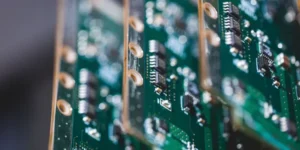We often need to quickly estimate the resistance of an alignment or plane on a printed circuit board rather than perform tedious calculations. Although there are now available printed circuit board layout and signal integrity calculation programs that can accurately calculate the resistance of an alignment, we sometimes want to take a quick and rough estimate during the design process.
There is a way to do this easily, called “square statistics”. With this method, the resistance of any geometric alignment can be accurately estimated in seconds (with an accuracy of about 10%). Once this method is mastered, the area of the printed circuit board to be estimated can be divided into squares, and once all the squares are counted, the resistance of the entire alignment or plane can be estimated.
Basic concepts
The key concept of the square statistic is that the resistance value of any size square PCB alignment (of defined thickness) is the same as any other size square. The resistance value of a square depends only on the resistivity of the conductive material and its thickness. This concept can be applied to any type of conductive material. Some common semiconductor materials and their bulk resistivities are given in Table 1.
The most important material for printed circuit boards is copper, which is the raw material used to manufacture most boards. Note: Aluminum is used for the metallization of integrated circuit chip cores, and the same principles of this article apply to aluminum.
Let’s start with the copper square in Figure 1. The length of this copper block is L, the width is also L (because it is square), the thickness is t, and the cross-sectional area of the copper foil area through which the current passes is A. The resistance of this copper block can be expressed simply as R = ρL/A, where ρ is the resistivity of copper (which is an inherent property of the material and is 0.67 μΩ/in. at 25°C).
But note that the section A is the product of the length L and the thickness t (A=Lt). The L in the denominator and the L in the numerator cancel each other out, leaving only R = ρ/t. Thus, the resistance of a copper block is independent of the size of the square; it depends only on the resistivity and thickness of the material. If we know the resistance of any size copper square, and can break the entire alignment to be estimated into multiple squares, we can add up (count) the number of squares to get the total resistance of the alignment.
How to achieve
To implement this technique, we just need a table that gives the resistance value of a square on a printed circuit board alignment as a function of the thickness of the copper foil. Copper foil thickness is typically specified in terms of copper foil weight. For example, 1oz. copper refers to a weight of 1oz. per square foot.
Table 2 gives the weights of the four most commonly used copper foils and their resistivities at 25°C and 100°C. Note that copper resistance values increase with temperature due to the positive temperature coefficient of the material.
For example, we now know that a 0.5oz. heavy square of copper foil has a resistance of about 1mΩ, a value that is independent of the size of the square. If we can break down the PCB alignment that we need to measure into multiple virtual squares, and then add those squares together, we get the resistance of the alignment.
A simple example
Let’s take a simple example. Figure 2 shows a rectangular copper alignment that weighs about 0.5oz. at 25°C, with an alignment width of 1″ and a length of 12″. We can break the alignment into a series of squares, each square side length is 1 inch. Thus, there are 12 squares in total. According to Table 2, each 0.5oz. heavy copper foil square has a resistance of 1mΩ. There are now 12 squares, so the total resistance of the alignment is 12mΩ.
How the inflection is calculated
For the sake of understanding, a very simple example was given earlier, so let’s look at the more complex case below.
In the previous example, we assumed that the current was flowing in a straight line along one side of the square, from one end to the other (as shown in Figure 3a). If the current were to make a right-angle bend (as in the right angle of the square in Figure 3b), we would find that the current path is shorter in the lower left part of the square than in the upper right part.
The higher current density as current flows through the corners means that the resistance of a corner square can only be calculated as 0.56 squares.
Now we see that the current path in the lower-left part of the square is shorter than the upper-right part. Therefore, the current will be crowded in the lower left region, where the resistance is lower. Therefore, the current density in this region will be higher than in the upper right region. The distance between the arrows indicates the difference in current density. The result is that the resistance of a corner square is equivalent to only 0.56 squares (Figure 4).
Likewise, we can make some corrections to the connectors soldered to the printed circuit board. Here, we assume that the connector resistance is negligible compared to the copper foil resistance.
We can see that if the connector occupies a large portion of the copper foil region to be evaluated, the resistance in that region should be reduced accordingly. Figure 5 shows the calculation of the three-terminal connector structure and its equivalent square (Ref. 1). The shaded area indicates the connector pins within the copper foil region.
A more complex example
We use a more complex example to illustrate how this technique can be used. Figure 6a shows a more complex shape, and calculating its resistance takes a bit of work. In this example, we assume that the copper foil weighs 1oz. at 25°C, and that the current direction is along the entire length of the alignment, from point A to point B. Both end A and end B have connectors placed on them.
Using the same technique as before, we can decompose a complex shape into a series of squares, as shown in Figure 6b. These squares can be of any suitable size, and different sizes can be used to fill the entire region of interest. As long as we have a positive square and know the weight of the copper alignment, we can know the resistance value.
We have a total of six completely square blocks, two square blocks that include connectors, and three corner blocks. Since the 1oz. copper foil has a resistance of 0.5mΩ/square, and current flows linearly through the six full squares, the total resistance of these squares is: 6 x 0.5mΩ = 3mΩ.
Then, we have to add two squares with connectors, each counted as 0.14 squares (Figure 5c). So, two connectors count as 0.28 squares (2 x 0.14). For 1oz. copper foil, this adds 0.14mΩ of resistance (0.28 x 0.5mΩ = 0.14mΩ).
Lastly, add the three corner squares. Each is calculated at 0.56 squares, for a total of 3 x 0.56 x 0.5mΩ = 0.84mΩ.
Therefore, the total resistance from A to B is 3.98mΩ (3mΩ + 0.14mΩ + 0.84mΩ).
Some of you may say: How can a PCB alignment be so oddly shaped? But often it is the power supply signal that needs to calculate the resistance of the alignment, and the power supply signal is sometimes implemented by copper cladding, creating some irregular shapes.
The conclusion is as follows:
Six full squares of 1 = 6 equivalent squares
Two connector squares of 0.14 = 0.28 equivalent squares
Three corner squares of 0.56 = 1.68 equivalent squares
Total number of equivalent squares = 7.96 equivalent squares
Resistance (A to B) = resistance of 7.96 squares, since each square is 0.5mΩ, so total resistance = 3.98mΩ
This technique can be easily applied to complex geometries. Once you know the resistance value of an alignment, it is easy to calculate other quantities (such as voltage drop or power consumption).
How the perforations are calculated
Printed circuit boards are often not limited to a single layer, but are stacked in different layers. vias are used to connect the alignments between the different layers. Each vias has a limited resistance and the resistance of the vias must be taken into account when calculating the total resistance of the alignment.
In general, when a vias connects two alignments (or planes), it constitutes a series resistive element. Multiple parallel vias are often used to reduce the effective resistance.
The calculation of the vias resistance is based on the simplified vias geometry shown in Figure 7. The current (as indicated by the arrow) along the length (L) of the vias passes through a cross-sectional area (A). The thickness (t) depends on the thickness of the copper layer plated on the inside of the vias.
After some simple algebraic transformations, the via resistance can be expressed as R=ρL/[π(Dt-t2)], where ρ is the resistivity of the copper plating (2.36 μΩ/in. at 25°C). Note that the resistivity of copper plating is much higher than that of pure copper. We assume that the thickness of the plating in the vias, t, is typically 1 mil, which is independent of the weight of the copper foil of the board. For a 10-layer board with a layer thickness of 3.5 mil and a copper weight of 2oz. the L is approximately 63 mil.
Based on the above assumptions, Table 3 gives the common over-hole sizes and their resistances. We can adjust these values higher or lower for our own particular board thickness. Alternatively, there are many free and easy-to-use over-hole calculation programs available online.
The above is a simple way to estimate the DC resistance of a printed circuit board alignment or plane. The complex geometry can be broken down into multiple copper squares of different sizes to approximate the entire copper foil area. Once the weight of the copper foil is determined, the resistance value of any size square is a known quantity. In this way, the estimation process is reduced to a mere count of the number of copper squares.















